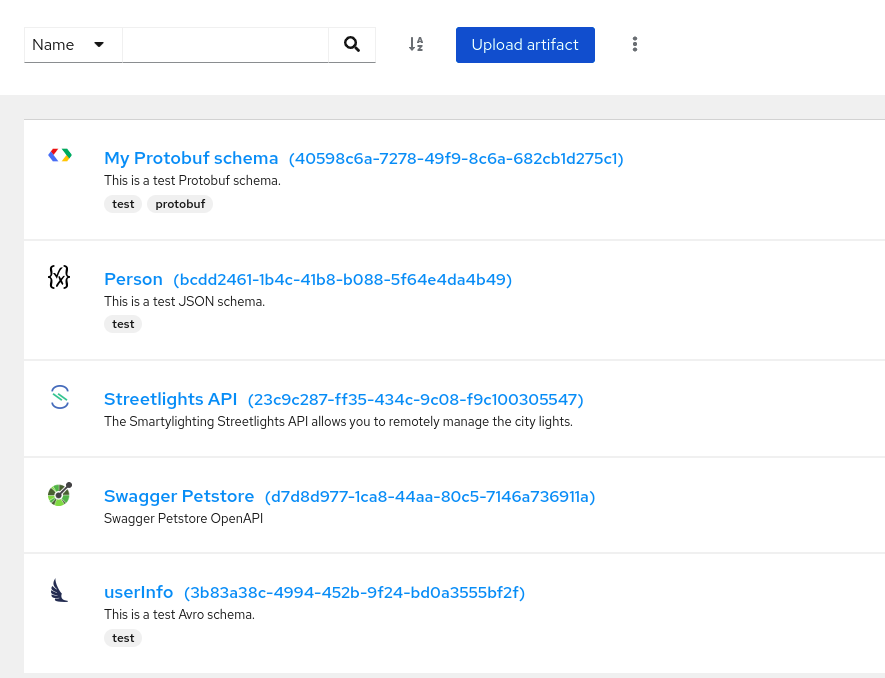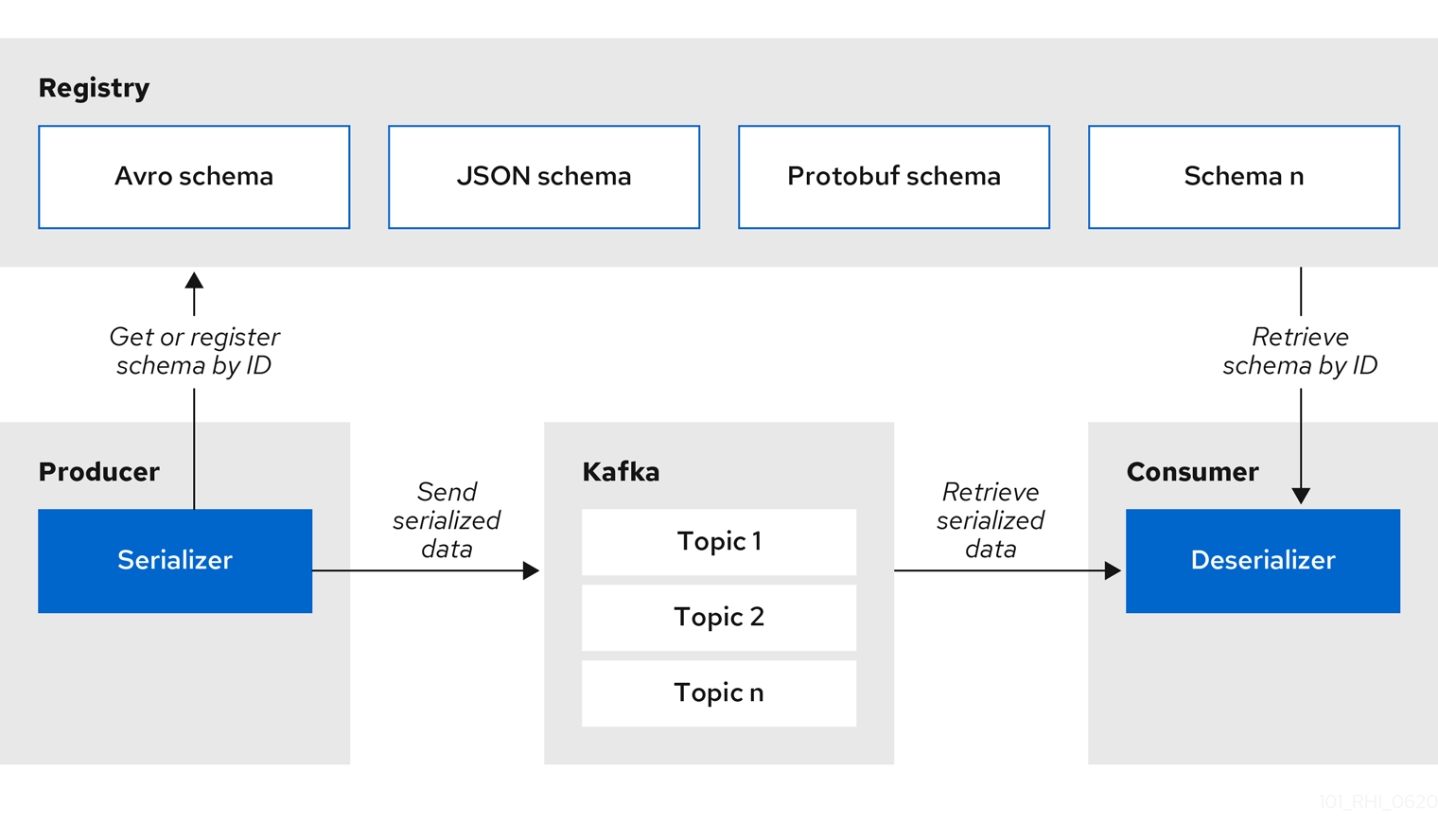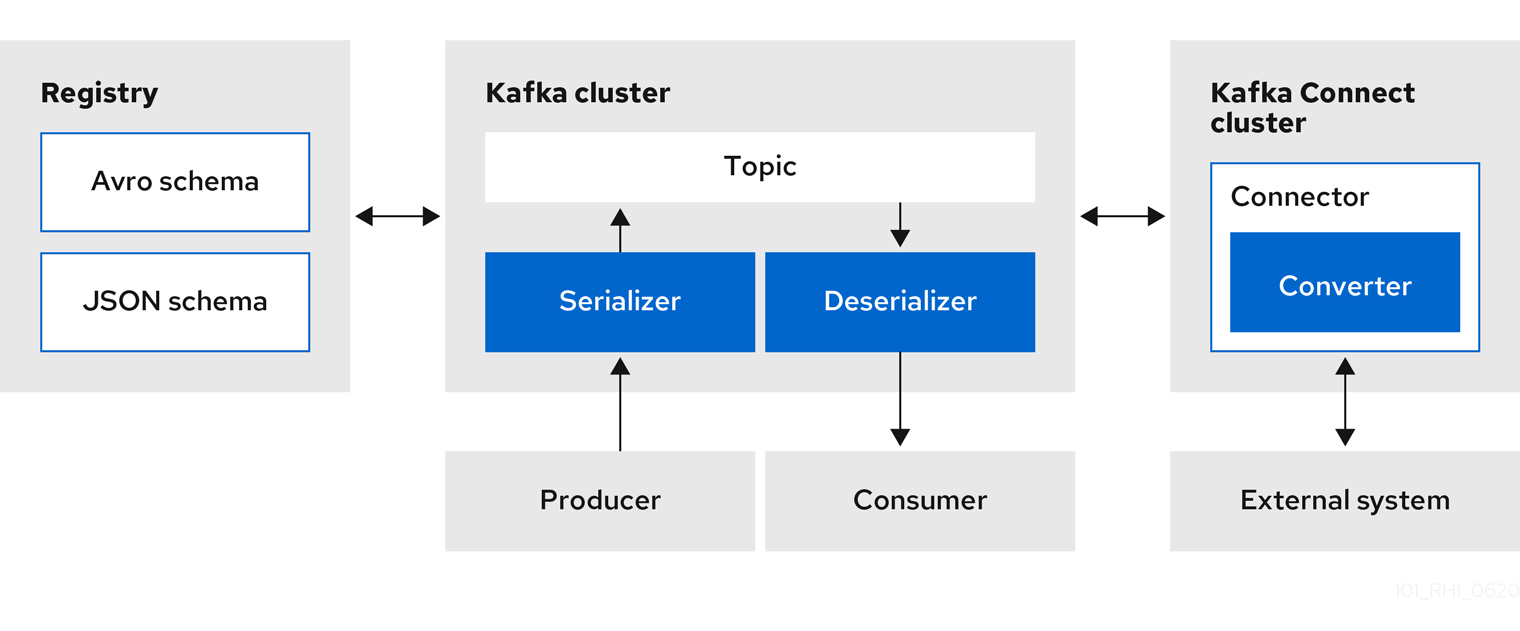이 콘텐츠는 선택한 언어로 제공되지 않습니다.
Chapter 1. Introduction to Service Registry
This chapter introduces Service Registry concepts and features and provides details on the supported artifact types that are stored in the registry:
- Section 1.1, “What is Service Registry?”
- Section 1.2, “Schema and API artifacts in Service Registry”
- Section 1.3, “Manage content using the Service Registry web console”
- Section 1.4, “Service Registry core REST API”
- Section 1.5, “Service Registry storage options”
- Section 1.6, “Validate Kafka messages using schemas and Java client serializers/deserializers”
- Section 1.7, “Stream data to external systems with Kafka Connect converters”
- Section 1.8, “Service Registry demonstration examples”
- Section 1.9, “Service Registry available distributions”
1.1. What is Service Registry?
Service Registry is a datastore for sharing standard event schemas and API designs across event-driven and API architectures. You can use Service Registry to decouple the structure of your data from your client applications, and to share and manage your data types and API descriptions at runtime using a REST interface.
For example, client applications can dynamically push or pull the latest schema updates to or from Service Registry at runtime without needing to redeploy. Developer teams can query the registry for existing schemas required for services already deployed in production, and can register new schemas required for new services in development.
You can enable client applications to use schemas and API designs stored in Service Registry by specifying the registry URL in your client application code. For example, the registry can store schemas used to serialize and deserialize messages, which are then referenced from your client applications to ensure that the messages that they send and receive are compatible with those schemas.
Using Service Registry to decouple your data structure from your applications reduces costs by decreasing overall message size, and creates efficiencies by increasing consistent reuse of schemas and API designs across your organization. Service Registry provides a web console to make it easy for developers and administrators to manage registry content.
In addition, you can configure optional rules to govern the evolution of your registry content. For example, these include rules to ensure that uploaded content is syntactically and semantically valid, or is backwards and forwards compatible with other versions. Any configured rules must pass before new versions can be uploaded to the registry, which ensures that time is not wasted on invalid or incompatible schemas or API designs.
Service Registry is based on the Apicurio Registry open source community project. For details, see https://github.com/apicurio/apicurio-registry.
Service Registry capabilities
- Multiple payload formats for standard event schema and API specifications such as Apache Avro, JSON Schema, Protobuf, AsyncAPI, OpenAPI, and more
- Pluggable registry storage options in AMQ Streams or PostgreSQL database
- Rules for content validation and version compatibility to govern how registry content evolves over time
- Registry content management using web console, REST API, command line, Maven plug-in, or Java client
- Full Apache Kafka schema registry support, including integration with Kafka Connect for external systems
- Kafka client serializers/deserializers (SerDes) to validate message types at runtime
- Compatibility with existing Confluent or IBM schema registry client applications
- Cloud-native Quarkus Java runtime for low memory footprint and fast deployment times
- Operator-based installation of Service Registry on OpenShift
- OpenID Connect (OIDC) authentication using Red Hat Single Sign-On
1.2. Schema and API artifacts in Service Registry
The items stored in Service Registry, such as event schemas and API designs, are known as registry artifacts. The following shows an example of an Apache Avro schema artifact in JSON format for a simple share price application:
Example Avro schema
When a schema or API design is added as an artifact in the registry, client applications can then use that schema or API design to validate that the client messages conform to the correct data structure at runtime.
Service Registry supports a wide range of message payload formats for standard event schemas and API specifications. For example, supported formats include Apache Avro, Google Protobuf, GraphQL, AsyncAPI, OpenAPI, and others.
Groups of schemas and APIs
An artifact group is an optional named collection of schema or API artifacts. Each group contains a logically related set of schemas or API designs, typically managed by a single entity, belonging to a particular application or organization.
You can create optional artifact groups when adding your schemas and API designs to organize them in Service Registry. For example, you could create groups to match your development and production application environments, or your sales and engineering organizations.
Schema and API groups can contain multiple artifact types. For example, you could have Protobuf, Avro, JSON Schema, OpenAPI, or AsyncAPI artifacts all in the same group.
You can create schema and API artifacts and groups using the Service Registry web console, core REST API, command line, Maven plug-in, or Java client application. The following simple example shows using the registry core REST API:
curl -X POST -H "Content-type: application/json; artifactType=AVRO" \
-H "X-Registry-ArtifactId: share-price" \
--data '{"type":"record","name":"price","namespace":"com.example", \
"fields":[{"name":"symbol","type":"string"},{"name":"price","type":"string"}]}' \
https://my-registry.example.com/apis/registry/v2/groups/my-group/artifacts
$ curl -X POST -H "Content-type: application/json; artifactType=AVRO" \
-H "X-Registry-ArtifactId: share-price" \
--data '{"type":"record","name":"price","namespace":"com.example", \
"fields":[{"name":"symbol","type":"string"},{"name":"price","type":"string"}]}' \
https://my-registry.example.com/apis/registry/v2/groups/my-group/artifacts
This example creates an artifact group named my-group and adds an Avro schema with an artifact ID of share-price.
Specifying a group is optional when using the Service Registry web console, where a default group is automatically created. When using the REST API or Maven plug-in, specify the default group in the API path if you do not want to create a unique group.
References to other schemas and APIs
Some Service Registry artifact types can include artifact references from one artifact file to another. You can create efficiencies by defining reusable schema or API components, and then referencing them from multiple locations. For example, you can specify a reference in JSON Schema or OpenAPI using a $ref statement, or in Google protobuf using an import statement, or in Apache Avro using a nested namespace.
The following example shows a simple Avro schema named TradeKey that includes a reference to another schema named Exchange using a nested namespace:
Tradekey schema with nested Exchange schema
Exchange schema
An artifact reference is stored in Service Registry as a collection of artifact metadata that maps from an artifact type-specific reference to an internal Service Registry reference. Each artifact reference in Service Registry is composed of the following:
- Group ID
- Artifact ID
- Artifact version
- Artifact reference name
You can manage artifact references using the Service Registry core REST API, Maven plug-in, and Java serializers/deserializers (SerDes). Service Registry stores the artifact references along with the artifact content. Service Registry also maintains a collection of all artifact references so you can search them or list all references for a specific artifact.
Supported artifact types
Service Registry currently supports artifact references for the following artifact types only:
- Avro
- Protobuf
- JSON Schema
1.3. Manage content using the Service Registry web console
You can use the Service Registry web console to browse and search the schema and API artifacts and optional groups stored in the registry, and to add new schema and API artifacts, groups, and versions. You can search for artifacts by label, name, group, and description. You can view an artifact’s content or its available versions, or download an artifact file locally.
You can also configure optional rules for registry content, both globally and for each schema and API artifact. These optional rules for content validation and compatibility are applied when new schema and API artifacts or versions are uploaded to the registry.
For more details, see Chapter 9, Service Registry artifact reference.
Figure 1.1. Service Registry web console
The Service Registry web console is available from http://MY_REGISTRY_URL/ui.
1.4. Service Registry core REST API
Client applications can use the Using the Service Registry core v2 REST API to manage the schema and API artifacts in Service Registry. This API provides create, read, update, and delete operations for:
- Artifacts
- Manage schema and API artifacts stored in the registry. You can also manage the lifecycle state of an artifact: enabled, disabled, or deprecated.
- Artifact versions
- Manage versions that are created when a schema or API artifact is updated. You can also manage the lifecycle state of an artifact version: enabled, disabled, or deprecated.
- Artifact metadata
- Manage details about a schema or API artifact, such as when it was created or modified, and its current state. You can edit the artifact name, description, or labels. The artifact group and when the artifact was created or modified are read-only.
- Artifact rules
- Configure rules to govern the content evolution of a specific schema or API artifact to prevent invalid or incompatible content from being added to the registry. Artifact rules override any global rules configured.
- Global rules
- Configure rules to govern the content evolution of all schema and API artifacts to prevent invalid or incompatible content from being added to the registry. Global rules are applied only if an artifact does not have its own specific artifact rules configured.
- Search
- Browse or search for schema and API artifacts and versions, for example, by name, group, description, or label.
- Admin
-
Export or import registry content in a
.zipfile, and manage logging levels for the registry server instance at runtime.
Compatibility with other schema registry REST APIs
Service Registry provides compatibility with the following schema registries by including implementations of their respective REST APIs:
- Service Registry core v1
- Confluent Schema Registry v6
- IBM Event Streams schema registry v1
- CNCF CloudEvents Schema Registry v0
Applications using Confluent client libraries can use Service Registry as a drop-in replacement. For more details, see Replacing Confluent Schema Registry.
1.5. Service Registry storage options
Service Registry provides the following options for the underlying storage of registry data:
| Storage option | Description |
|---|---|
| PostgreSQL 12 database | PostgreSQL is the recommended data storage option for performance, stability, and data management (backup/restore, and so on) in a production environment. |
| AMQ Streams 2.1 | Kafka storage is provided for production environments where database management expertise is not available, or where storage in Kafka is a specific requirement. |
1.6. Validate Kafka messages using schemas and Java client serializers/deserializers
Kafka producer applications can use serializers to encode messages that conform to a specific event schema. Kafka consumer applications can then use deserializers to validate that messages have been serialized using the correct schema, based on a specific schema ID.
Figure 1.2. Service Registry and Kafka client SerDes architecture
Service Registry provides Kafka client serializers/deserializers (SerDes) to validate the following message types at runtime:
- Apache Avro
- Google protocol buffers
- JSON Schema
The Service Registry Maven repository and source code distributions include the Kafka SerDes implementations for these message types, which Kafka client application developers can use to integrate with the registry.
These implementations include custom Java classes for each supported message type, for example, io.apicurio.registry.serde.avro, which client applications can use to pull schemas from the registry at runtime for validation.
1.7. Stream data to external systems with Kafka Connect converters
You can use Service Registry with Apache Kafka Connect to stream data between Kafka and external systems. Using Kafka Connect, you can define connectors for different systems to move large volumes of data into and out of Kafka-based systems.
Figure 1.3. Service Registry and Kafka Connect architecture
Service Registry provides the following features for Kafka Connect:
- Storage for Kafka Connect schemas
- Kafka Connect converters for Apache Avro and JSON Schema
- Registry REST API to manage schemas
You can use the Avro and JSON Schema converters to map Kafka Connect schemas into Avro or JSON schemas. Those schemas can then serialize message keys and values into the compact Avro binary format or human-readable JSON format. The converted JSON is also less verbose because the messages do not contain the schema information, only the schema ID.
Service Registry can manage and track the Avro and JSON schemas used in the Kafka topics. Because the schemas are stored in Service Registry and decoupled from the message content, each message must only include a tiny schema identifier. For an I/O bound system like Kafka, this means more total throughput for producers and consumers.
The Avro and JSON Schema serializers and deserializers (SerDes) provided by Service Registry are also used by Kafka producers and consumers in this use case. Kafka consumer applications that you write to consume change events can use the Avro or JSON Serdes to deserialize these change events. You can install these SerDes into any Kafka-based system and use them along with Kafka Connect, or with Kafka Connect-based systems such as Debezium and Camel Kafka Connector.
1.8. Service Registry demonstration examples
Service Registry provides open source example applications that demonstrate how to use Service Registry in different use case scenarios. For example, these include storing schemas used by Kafka serializer and deserializer (SerDes) classes. These Java classes fetch the schema from the registry for use when producing or consuming operations to serialize, deserialize, or validate the Kafka message payload.
These example applications include the following:
- Apache Avro SerDes
- Google Protobuf SerDes
- JSON Schema SerDes
- Confluent SerDes
- Custom ID strategy
- REST client
- Cloud Events
- Quarkus and Kafka
- Apache Camel with Quarkus and Kafka
1.9. Service Registry available distributions
Service Registry provides the following distribution options.
| Distribution | Location | Release category |
|---|---|---|
| Service Registry Operator |
OpenShift web console under Operators | General Availability |
| Container image for Service Registry Operator | General Availability | |
| Container image for Kafka storage in AMQ Streams | General Availability | |
| Container image for database storage in PostgreSQL | General Availability |
| Distribution | Location | Release category |
|---|---|---|
| Example custom resource definitions for installation | General Availability | |
| Service Registry v1 to v2 migration tool | General Availability | |
| Maven repository | General Availability | |
| Source code | General Availability | |
| Kafka Connect converters | General Availability |
You must have a subscription for Red Hat Integration and be logged into the Red Hat Customer Portal to access the available Service Registry distributions.


